CATTLE.
213
CATTLE.
Characteristics of Guernsey . ... 913
Description of......... 213
Diseases of Cattle:
Abortion .......... 217
Albuminuria......... 219
Bloody Milk......... 219
Bronchitis.......... 221
Coat........... 217
Chapped Teats........ 221
Colic........... 221
Constipation........ . 221
Cattle Plague........ 222
Diarrhea.......... 221
Dysentery......... 221
Garget........... 221
Diseases of Cattle:
Grub........... 222
Hernia.....•••••• 222
Hoven ....••••••• 222
Inversion of the Uterus..... 222
Jaundice ...... ... • 222
Leucorrhea......... 222
Lice . . . ........ • 222
Loss of Cud ...... .. • 222
Muzzle ........... 217
Puerperal ........... 222
Position .......... 217
Pneumonia......... 222
Pluro Pneumonia...... . 222
Sanitation.......... 217
Diseases of Cattle f
Sore Throat ............ 222
Tuberculosis . . ...... . 222
Ventilation . ....... . 217
Experience with Guernsey. .... 215
Features of Guernsey ...... 215
Guernsey versus Jersey...... 214
Guernsey, as a Butter Cow .... 214
Guernsey Cattle Club ...... 214
Grade Guernsey ........ 215
History of Guernsey ....... 213
Naming . ........ . . 213
Points of Guernsey ...... . 214
Registering ... . ...... 214
Standard ........... 214
Guernsey. — The Guernsey breed of cattle takes
its name from the little Island of Guernsey, one
of the Channel islands. The origin of the cattle
of these Channel islands, among which are the
Island itself, which is cut off from the main land by
a little strip of sea, and protected by the rock-bound
coast. The one aim of the inhabitants was to pro
duce a cow excelling all others in butter production.
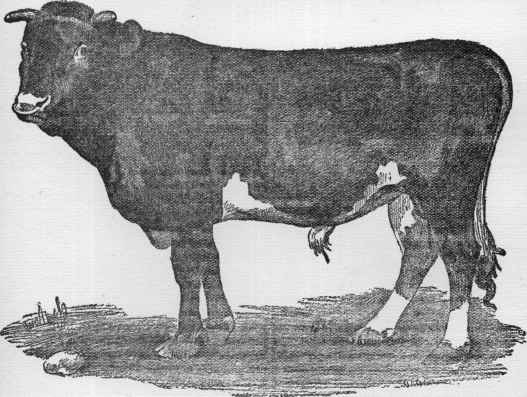
Mr. Pearsons’ Imported Guernsey Bull.
Alderneys, Guernsey, Jersey, and Sarc, is greatly
disputed, but the stock is thought to have come
originally from Normandy and Brittany, and that
this breed was laid by crossing the Normandy bull
upon the Brittany cow. It is noticeable that the
Guernsey cattle partake of the characteristics of the
The Guernsey is the result, producing butter of
the finest natural color with the least outlay for feed.
Up to recent date the Guernseys in America were
kept for family use, but in 1840 they were intro
duced into private dairies around Philadelphia, and
since then have kept their place ahead of all others.
214 THE FRIEND OF ALL
A little later the Massachusetts Society for the Pro
motion of Agriculture, foreseeing the future of this
breed, imported some, and distributed them in a
public sale to different dairy men in the State.
Later on, they were adopted by Connecticut farm
ers ; so on Feb. 7, 1877, the American Guernsey
Cattle Club was organized in New York State.
There were only about 150 pure bred Guern
seys in the country at that time whose pedi
grees could be traced to the Island. Today
there are about 14,000 animals registered.
The Guernsey differs from the Jersey in many
respects. They have not the deer-like appear
ance of the Jersey; they are coarser in bone,
heavier in carcass, and being larger every way,
are less precocious. They are first allowed to
calve at about two
and a half years old,
which gives them
more size. It is a
well-known fact that
the size of the calves,
and the aptitude of
the cattle to make
beef and turn off well
when their usefulness
in the dairy is from
any cause at an end,
are matters of no
small importance to
the so-called “ com
mon farmers ; “ that
is, those who are
obliged to study
closely the economy
of farming. So
strong are the characteristics of the race that
grades or even half breeds possess the best quali
ties of full bloods to a remarkable degree. Every
point of the Guernsey is rich in itself— the horn
is soft and full, the hoofs are
most frequently like tortoise-
shell, the skin is soft and
yellowish in tint. The pre
vailing color of the animal
itself is a delicate shade of
fawn with white markings,
and a cream-colored nose.
The greatest characteristic is
the golden color around the
eye, on the bag, at the base
of the horns, and at the end
of the tail bone. The dis
position of these cattle is re
markably affectionate and
quiet, and the cow is pre-
eminently the one for dairy
use. The rich golden color
of the cream and butter cannot be excelled. The
animal has the ability of fattening rapidly when
dried off. The cows are of good size and hardy.
The cream is very thick and yellow; the milk is
rich and yields a very large percentage of cream.
The Guernsey cow gives as fine golden butter as
the Jersey, and a large quantity of it. The cele
brated cow, Bretonne, gave 539 pounds of butter,
and nearly 100 cows have been reported to have
made a record of 14 pounds of butter or over a
week.
These animals have a strong constitution and well-
developed udders. The bulls most commonly used
in the Island of Guernsey are one and two years
old. The animals are very docile and pay no atten-
j tion to visitors. The influence which pure bred
[ bulls exert is readily acknowledged. They inten-
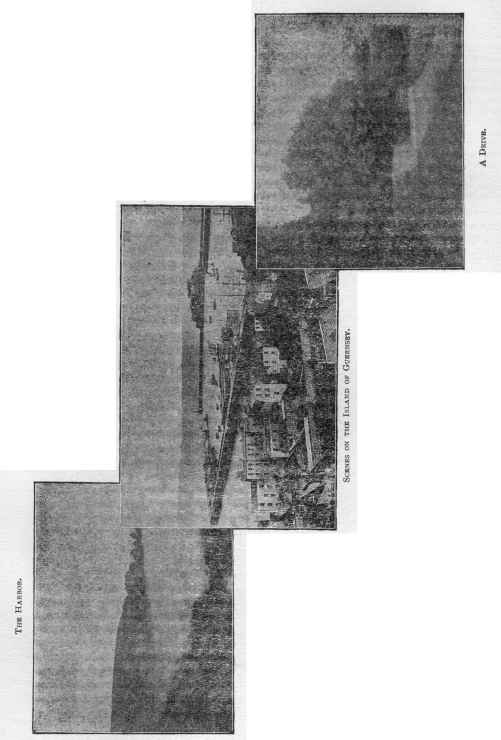
CATTLE. 215
sify the good qualities of the breed, and pro
duce animals of great physical strength and
size without sacrificing the richness of the
milk production.
The Guernsey Grade Cow.—This cow has
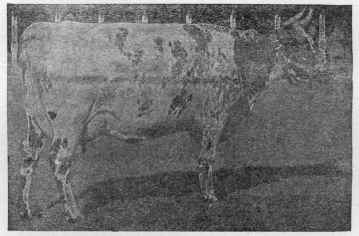
AYRSHIRE COW.
been found to be a great success, as the best
characteristics of the race are preserved, and as
each year American dairymen are demanding
more and more a strictly dairy cow, and a dairy
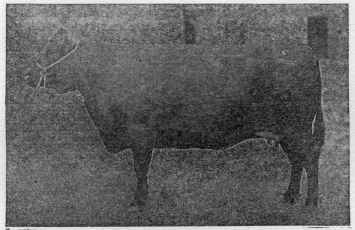
POLLED ANGUS COW.
bred one as well. This six years’ experience is
quoted from Hon. Lewis F. Allen, of Buffalo,
N. Y. He commenced the use of the regis
tered Guernsey bull upon his registered high-
grade Short-Horn cows in the year 1880.
“My own experience thus far in the use of
grade Guernsey cows sired by Guernsey bulls
or high-grade Short-Horn cattle is altogether
satisfactory. My first-grade Guernsey heifers,
eight or ten in number, were calved in 1882,
and continuously on in every succeeding year
until now. So I have at the present time sev
eral three-fourths bred already in milk. Alto
gether of Short-Horn grade, Guernsey grades,
younger heifers, and heifers’ calves, they number
a herd of fully 100, of which about seventy are
from Guernsey sires, thoroughbred bulls. Fifty
regular milch cows are now used in my butter
dairy, the older grade Short-Horn cows, which are
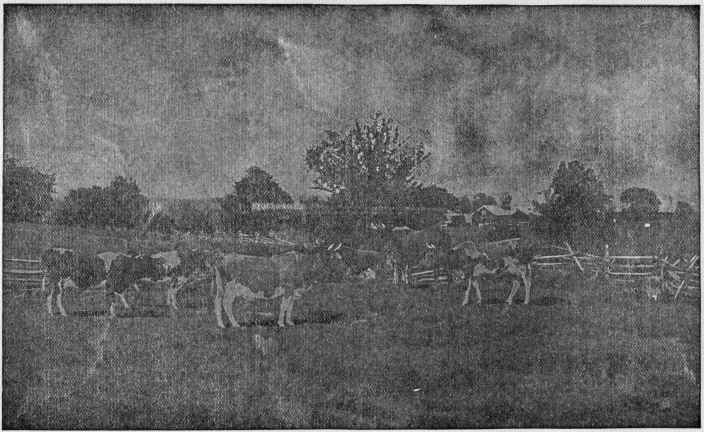
Mr. Pearson's Guernsey Cattle.
CATTLE. 217
continuously drawn out for sale or beef as the I
young Guernsey heifers bring forth their calves to
take their places, being not quite thirty in number.
The Guernsey heifers usually bring their first calves
at from 20 to 26 months old; and of all those, there
have been but two or three accidental failures to
prove first-class milkers, giving within a month or
two after dropping their first calves 24 to 40 pounds
of rich milk per day. All of them have large, square
udders, sizable teats, and are easy and gentle
milkers. "
DISEASES OF CATTLE.
General Indications of Disease in Cattle.—The coat
of the animal is an indication of the state of health,
a “ staring-coat “ being a symptom of low condi-
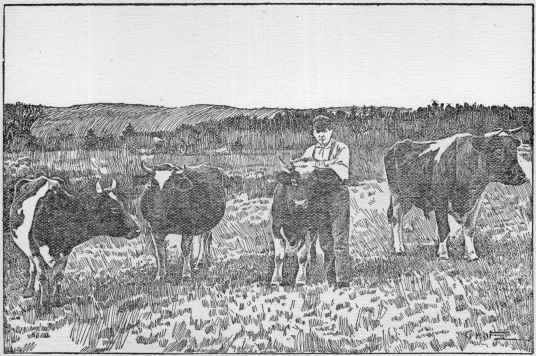
Mr. Pearsons’ Guernsey Cattle.
tion. The peculiar positions of standing, lying
down, getting up or of moving about are significant.
The muzzle of the healthy cow or ox is moist, but
in disease becomes either hot or cold, and some
times changes color. Ventilation and proper sani
tation will prevent cattle from having disease, with
an abundance of pure water, proper food and fre
quent change of diet. Many animals are lost
through the ignorance of quacks, while judgment
and common sense are all that is necessary.
A few of the most common diseases and their pre
ventive will be given.
Abortion.—Abortion, or the dropping of calves, is
a source of great loss to farmers and dairy men, and
is liable to occur almost any month of gestation,
particularly from the sixth to the ninth. As a rule,
a cow who has once lost a calf will never be a safe
breeder; and sometimes it happens that abortion,
like a contagious disease, will spread through an
entire herd.
Principal Causes of Abortion.—A fright, injury or
violent exertion may cause this ; therefore, pregnant
cows should be treated as gently and quietly as pos
sible. Want of food sometimes causes abortion.
Rye, bran and potatoes in large quantities or musty
hay and fermented meal, as well as the ergotized
grains should never be fed to pregnant animals.
Symptoms of Abortion.—The first symptom is usu
ally a loss of appetite, the animal seeming dull and
listless, the milk diminishing in quantity. After
a time the cow grows restless, and there will be a
watery discharge from the vagina, followed a little
later by the discharge of the fetus ; more or less
discharge of a bloody mucus will follow for several
days after the loss of the fetus. The afterbirth
usually becomes decomposed and comes away in
fragments, being very offensive in odor.
Treatment.—As soon as the symptoms are dis
covered the animal should be separated from the
rest and put into a comfortable shed. If the fetus
has motion it is not dead. If the discharge be fetid
it is a sure indication the fetus is dead, and the
sooner it is gotten rid of the better. If the water
sack inclosing the fetus has not been previously
broken this should be done, using the greatest care
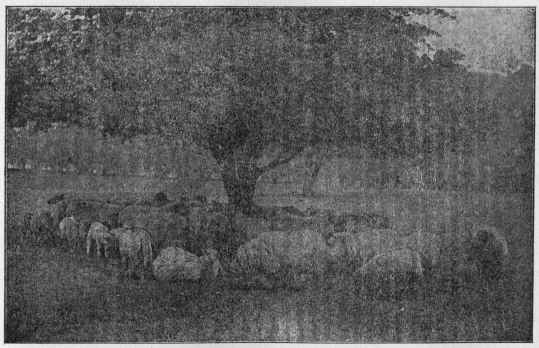
A MODEL UPLAND SHEEP PASTURE
This includes good grass and running water with woods sufficient for shade and protection
CATTLE. 219
in order not to puncture the womb, which would
cause death to the animal. The afterbirth should
be removed in the most careful manner, then syringe
out the parts with warm water and follow with an
injection of carbolic lotion as follows :
One ounce of carbolic acid to the gallon of water,
inject into the womb half a pint two or three times
a day for a week or ten days.
Too much importance cannot be placed upon the
necessity of removing all traces of the fetus and
placenta or afterbirth by burying them at a distance
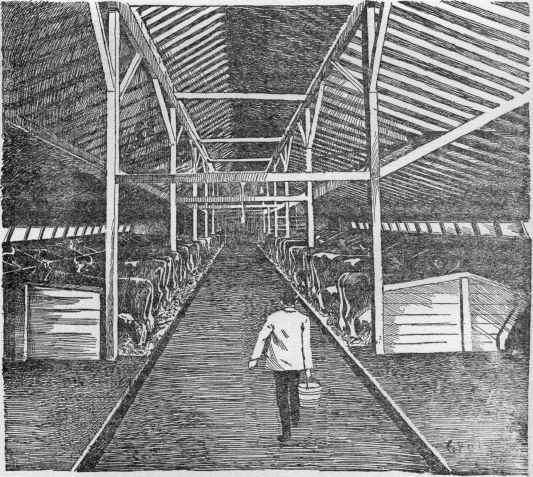
Interior of Guernsey Stable.
from the places frequented by the herd, and cleans
ing the stable before it is occupied by other animals.
Albuminuria.—This disease is similar to Bright's
disease, and is supposed to be caused by an impov
erished condition of the blood or a too long contin
ued sameness of food. The most common symptom
is the stretching of the body at full length, and get
ting the fore and hind feet as far apart as possible.
Other symptoms are, constipation, unnatural gait
with the hind feet far apart, stiffness and reluc
tance to move, urine of a mucilaginous character
and dark in color. Discontinue all green food
except grass and ensilage, and give plenty of grain
with milk and eggs. Give one dose of the following:
Epsom salts 12 oz., ginger 1 oz., gentian 1 oz.,
syrup 4 oz., water sufficient to make two quarts. If
this does not effect a cure give the following:
Two drams sulphuric acid, 1¼ oz. tincture carda
moms, mixed thoroughly with a pint of water.
Anthrax or black leg is a common disease and
greatly to be feared being a ligament and contagious.
It appears externally and internally, and turns the
affected parts black. It does not last long and the
animal usually sinks in a few hours. Chloride of
potassium in one to three dram doses dissolved
in water is a good medicine. Whisky or quinine
may also be useful, but prevention is better than
cure.
Bloody Milk—It sometimes happens that the
blood is mixed with the milk, and in this case the
following is a good remedy:
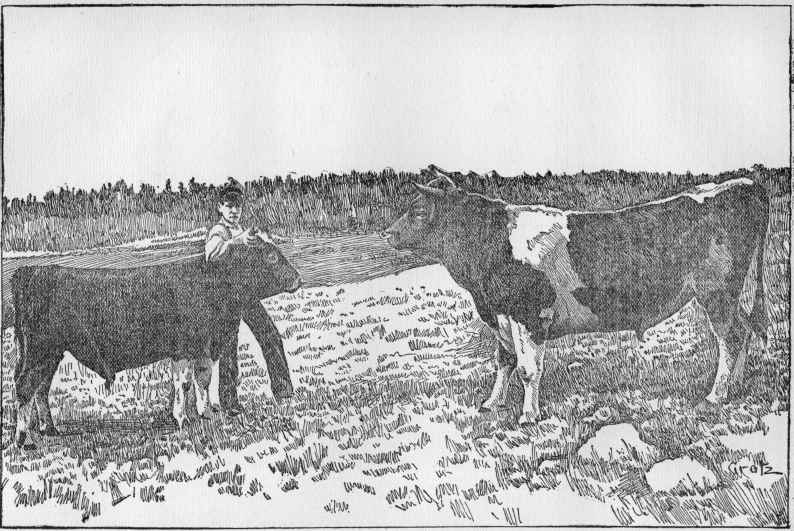
Mr. Pearsons’ Imported Bull and get, Don of Hampden, and Medicine Bull.
CATTLE.
221
Three drams of camphor, 3 oz. of powdered oak
bark, 3 oz. powdered ginger, mix and divide into
six doses, giving a dose night and morning in a
pint of gruel.
Bronchitis.—This is an inflammation of the mu
cous membrane of the bronchial tubes. The symp
toms are rapid, painful breathing, a severe cough
with fever and a rapid pulse. The animal should
be kept in a warm, comfortable stable, and fed with
warm, soft food. Epsom salts in from eight to ten
doses is a good remedy, also put a mustard paste
on the lower part of the throat and sides of the
chest. Give the animal all the water wished for.
Constipation.—This may be prevented by attend
ing carefully to the diet of the animal, and allowing
a liberal supply of salt so that they will drink freely.
Diarrhea.—This is caused by sudden change of
diet, or by improper food. A mild purgative should
first be given, then a laxative as follows :
One half a pound of Epsom salts, ½ oz. ginger, 2
dr. of gentian mixed with one pint of gruel. This
should be followed in a day or so by an astringent
such as this:
Two ounces of prepared chalk, 1 oz. of powdered
oak bark, 2 dr. of ginger, 2 dr. of powdered catechu,
½ dr. powdered opium, 1 oz. of peppermint water;
mix and give in a quart of warm gruel. In the
case of calves begin with a laxative, as:
Two ounces of castor oil with a tablespoonful of
powdered ginger.
Chapped Teats.—Bathe in warm water and wipe
dry, then apply fresh, melted lard or sweet cream
which has been simmered in oil, also use witch-
hazel for bathing.
Colic.—This is caused from constipation, or
drinking too much cold water when heated. The
symptoms are restlessness and groaning, the ani
mal frequently gets up and down and the body be
comes bloated. The following remedy is advisable :
To 1 qt. of warm water add 1 pt. of molasses, 8
oz. of linseed oil, ½ oz. of powdered ginger, mix
well and give in one dose. Inject the following:
To 2 qts. of blood-warm water add 6 oz. of olive
oil.
Dysentery.—The symptoms are watery, bloody,
and offensive discharges from the bowels, with fever
thirst, pain, and loss of appetite. The patient should
be kept warm, and not allowed too much to drink,
while the following may be given, one half by
mouth and the other half by injection :
One-half ounce chloride of lime, ½ oz. tincture of
arnica, 1 oz. sulphuric ether mixed with 2 qts. starch
gruel. Fine hay, oatmeal, boiled potatoes, linseed
meal may be given.
Garget. — This is an inflammation of the udder.
The milk hardens, the animal is feverish, and has
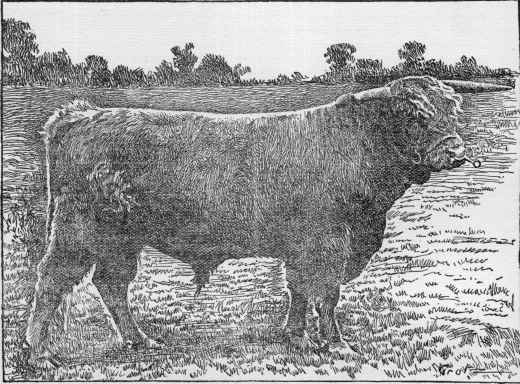
A Fine Specimen.
222
THE FRIEND OF ALL
chills followed by fever with disordered bowels.
When in the case of young calves about to calve, it
is well to draw a little milk each day before parturi
tion. A poultice may be applied to the udder with
holes for the teats and fastened over the back of
the animal with a strap. If there should be suppu
ration and the matter does not escape of itself the
swelling should be lanced.
Grub.—This is caused by the gad-fly piercing the
skin and depositing its eggs. The only method is
to destroy the larvae which the fly has laid under
the skin. This may be done by enlarging the ori
fice with a penknife and pressing out the larvae.
Rub the places with turpentine or kerosene oil.
Hernia.—This is a rupture and denotes a protru
sion of the bowels through an opening of the abdo
men. The displaced parts should be pushed back
and retained in their place by a strap along the
back and under the belly, with one around the neck.
Hoven.—This is an unnatural distention of the di
gestive organs and is produced by the fermenting of
food in the stomach. Four drams of chloride of lime
in a little water will give relief if given in the first
stages. If the gas cannot be removed in any other
way an opening is made into the stomach, but it is
a dangerous remedy. A purgative should follow
consisting of 12 oz. Epsom salts, ginger 1 oz.,
molasses 4 oz., mix with 2 qts. of water; the food
should be light, and changed from hay to grass or
from grass to hay gradually.
Inversion of the Uterus.—This is not common, but
sometimes occurs at the time of calving or right
after, and it is caused by the violent expulsive
action of that organ at the moment of expelling
the calf. This should be returned to place without
rupturing the membrane, which would cause death.
The head of the animal should be secured and the
hind quarters raised a foot or more. Dip a sheet
in warm milk and water and lay carefully over the
protruding mass, cleanse thoroughly, and carefully
return to place. After replacing the uterus inject
an ounce of laudanum.
Jaundice.—This is a liver disease, the symptoms
being a yellow tint of the eye which finally spreads
over the whole skin. The following may be used:
Carbonate of soda 2 dr., cascarilla bark 3 dr.,
ginger 3 dr. in a pint of ale.
Sore Throat.—Mustard paste may be rubbed
upon the throat, rubbing off after two or three hours
and replacing, then apply a linseed poultice. A lit
tle of the following mixture may be syringed down
the throat several times a day. Two ounces chlorate
of potash in 1 qt. of water.
Leucorrhea or Whites.—This is simply catarrh of
the vagina and womb, which in appearance is a
whitish fluid and very offensive in odor. A syringe
of warm water will generally end the trouble.
Lice.—Cattle should never be permitted to have
this pest. A sharp lookout must be kept. Lard
may be applied warm and well rubbed in along the
spine, neck, shoulders and sides of the body. Kero
sene is also destructive.
Loss of Cud.—Give warm bran mashes and plenty
of pure water with a moderate quantity of cut vege
tables and apples.
Pleuro-Pneumonia.—This is a disease of the lungs
causing great weakness and prostration of the whole
system. The best remedy is to kill the animal, and
remove all danger from the rest of the herd.
Pneumonia.—This is common among cattle and
has three stages,—Inflammation, the lung becoming
solid, and suppuration. Keep the animal in a warm,
well-ventilated stable, and if feverish cover the body
with blankets wrung out in hot water to induce per
spiration, using the same treatment as in bronchitis.
Puerperal Fever.—This is usually caused by diffi
cult parturition, exposure to cold soon after calving
or retention of the placenta. Symptoms are a high
fever, hot, dry muzzle, hot or cold horns, loss of
appetite, staring eyes, restlessness, scanty urine and
constipation. If the udder is much swollen and hot,
treat it with the water-bag, which is made of rubber
large enough to inclose the udder, and comes up to
the body flaring at the top, and is laid over the back
with a strap. This is filled with warm soft-water,
65 degrees. Give a purgative, and keep the animal
in a warm, clean stable.
Rinderpest or Cattle Plague.—Is hopeless of cure;
thus the best thing to do is to kill the animal, and
bury it where it will not contaminate anything.
Tuberculosis.—This is really consumption, and is
to be most carefully looked for in every animal.
They should be tested frequently, and if found dis
eased, should be killed.

But first, if you want to come back to this web site again, just add it to your bookmarks or favorites now! Then you'll find it easy!
Also, please consider sharing our helpful website with your online friends.
BELOW ARE OUR OTHER HEALTH WEB SITES: |
Copyright © 2000-present Donald Urquhart. All Rights Reserved. All universal rights reserved. Designated trademarks and brands are the property of their respective owners. Use of this Web site constitutes acceptance of our legal disclaimer. | Contact Us | Privacy Policy | About Us |